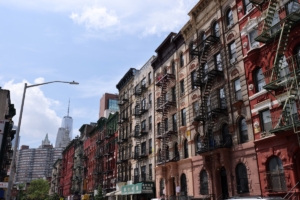
Nearly half of homes to hit the NYC market last spring didn’t sell. What does that mean for buyers and sellers this year?
In 2018, a historic wave of homes hit the New York City sales market, as price growth began to sputter and owners looked to cash out. More than 12,000 homes were listed for resale on StreetEasy during the peak listing months of March, April, and May, saturating the market and giving buyers negotiating power.
Yet despite record low unemployment citywide and a stock market that hit record highs in September, fewer than half of these homes found buyers as of early 2019 — and the vast majority that did sold significantly below their asking price.
With inventory levels still near historic highs, we looked back at 2018’s for-sale inventory and found five big lessons for New Yorkers preparing for this year’s home-shopping season.
1. Of All Homes Listed for Sale in Spring 2018, Fewer Than Half Sold
Just 48 percent of the homes listed during March, April, and May 2018 had sold as of February 2019. While weakness at the top of the NYC sales market has been grabbing headlines, the sluggish pace of sales has extended to homes across boroughs and price points. Manhattan homes fared slightly worse than others, with just 44 percent selling, but even in the comparably strong market in Queens, just 54 percent of homes found buyers. This is not only about price: Though 61 percent of all homes listed for $1 million or more failed to sell, so did 45 percent of all homes priced under $1 million. (Nonetheless, units priced at or above $5 million fared far worse, with just 140 of 656 units, or 21 percent, finding buyers.)
The Greenwich Club condominium in the Financial District exemplifies this trend. A total of 31 units in the building were listed for sale in March, April, and May 2018, but only six have sold. One more entered contract in December, and another six have since relisted, but many — including a 1-bedroom asking $1.25 million, 25 percent above its 2016 purchase price — left the market without fanfare in late 2018.
2. Many Homes Listed Last Spring Were Taken Off-Market
Most sellers who were unable to find buyers at suitable prices have simply pulled their listings from the market. Of all listings created in spring 2018, 40 percent are either paused, delisted, or otherwise no longer available on StreetEasy. Only 7.5 percent of all the listings from the peak months, or 14 percent of the total unsold units, are still actively seeking buyers. Listing agents marked another 4.5 percent of homes as in-contract, with the majority entering deals in late 2018 and presumably closing in early 2019. Yet with many more unsold, we will likely continue to see heightened inventory heading into the spring home-shopping season, as these sellers try again to find a buyer.
3. The Majority of 2018 Sales Closed Below Asking Price
Of homes listed last spring that managed to find a buyer, we estimate that 70 percent closed below their initial asking price[1]. The median difference between the recorded closing price (as reflected in public records) and the initial listing price on StreetEasy was 5.5 percent, for a $44,000 discount off the $800,000 median listing price for homes sold. Buyers enjoyed particularly high negotiating power in Manhattan, where 77 percent of homes sold below their initial asking price, compared to 68 percent of homes in Queens and 61 percent of homes in Brooklyn.
Homes selling below their initial asking price is not a new phenomenon, but with heightened competition for buyer interest, spring 2018 was particularly painful for sellers. In 2017 and 2016, 62 and 61 percent, respectively, of homes listed in the spring sold below ask in a comparable time period.
4. Aggressively Priced Homes Stand Out
Though these numbers make selling a home seem daunting, a significant chunk of homes — 19 percent of all sales — closed above their original asking price. While these home sales ranged across price points and neighborhoods, they tended to be among the cheapest in their respective neighborhoods for their bedroom count. Homes that ultimately sold above ask were initially listed for a median of 8.8 percent below the respective 2018 median price for their neighborhood and bedroom count. Meanwhile, homes that sold below asking price were listed a median of 1.2 percent above the respective median for their neighborhood and bedroom count. Homes that went unsold were initially listed for a median of 6.4 percent above their respective benchmark median.
5. StreetEasy Saves Reflect Pricing and Buyer Interest
Listings that were priced to sell drew strong interest early on. StreetEasy users saved units that sold above asking price almost twice as much during the first seven days as units that sold below ask, and nearly three times as much as units that failed to find a buyer. After four weeks on StreetEasy, units that sold above ask received an average of 57 saves, compared to just 21 for units that failed to sell.
Aggressive pricing and strong user interest translated to a shorter time on market. The roughly 1,000 homes listed in the spring that sold above asking price spent just four weeks on the market before entering contract, compared to more than nine weeks for units that sold below ask.
What This Means for Buyers and Sellers in 2019
We expect another large wave of inventory to hit the market again in 2019 — one that will likely include many of the units listed but unsold in 2018. Price growth over the course of 2018 has been weaker than in years past, particularly in Manhattan, and inventory remains high. For sellers still seeking buyers, then, the situation calls for a clear strategy: cut prices.
Sellers may be tempted to hold out in the hope that some buyer will pay far above what others are offering. But with falling prices in many areas of the city, and inventory lingering on the market, such an outcome is highly unlikely. Many are willing to buy, but almost no one will be willing to pay more than what the broader market demands.
Buyers, on the other hand, should note the importance of doing their research. Pay special attention to how listing prices compare to neighborhood benchmarks, and the demand — illustrated by StreetEasy saves and open house attendance — that various listings attract. The tips we laid out last summer will still serve well: Be picky, be patient, and be prepared to negotiate.
How We Did It
We examined all sale listings created on StreetEasy in March, April, and May of 2018, and examined both their listing status and public sale records from the New York City Department of Finance to determine whether or not each unit had been sold. For 88 percent of units marked as sold on StreetEasy, we were able to attach a final sale price based on public records, and thus determine whether these units were sold at, above, or below asking price.
[1] Estimate based on the 42 percent of StreetEasy listings created in March, April, and May, with corresponding government sale records. StreetEasy was unable to attach public records to an additional 6 percent of homes recorded marked as sold.
—
Got an interesting NYC real estate story or a hot tip? Send it to us at tips@streeteasy.com. (You will remain anonymous.) And hey, why not like StreetEasy on Facebook and follow @streeteasy on Instagram?








